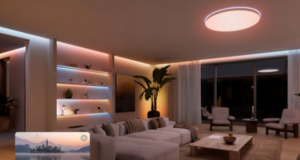
Light shelves work on a fairly basic principle. A shelf is installed outside of a window, which reflects additional light back into a room. They are particularly effective for houses where eaves might otherwise reduce the amount of light entering a window at certain times of the day.

How light shelves work
Light shelves work on a fairly basic principle. A shelf is installed outside of a window, which reflects additional light back into a room. They are particularly effective for houses where eaves might otherwise reduce the amount of light entering a window at certain times of the day. Because they bounce light upwards into a room from below (rather than from above, as is the case with direct light into a window), light shelves are particularly useful for casting daylight further into a room than might otherwise be possible, and for reducing shadows caused by light coming directly through a window. Of course, the distance that light is cast depends on the time of day and year, and the orientation of the house.
Planning ideal light shelves
The best light shelves are made of an aluminium chassis and aluminium panel that are mounted horizontally and located above eye-level (as seen in the image). The ceiling should be painted with a reflective, light coloured paint, and it is important to design light shelves specifically for each window (width, angle etc.) to meet the desired outcome. A lighting designer can advise you best on where light shelves are appropriate, and how they should be designed to work in conjunction with the rest of your lighting design.
Because light shelves can introduce light considerably further into a room than might otherwise be possible through a window, curtains or blinds may also be necessary so you can adjust the brightness of the room for comfort as needed.
Light shelves are by no means ideal for every climate. They are preferable in mild climates, because their use in warmer climates leads to excessive heat gain and a greater reliance on air conditioning (and therefore greater power usage, leading to higher bills).





